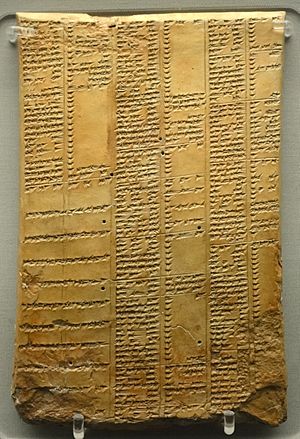Ditto mark facts for kids
The ditto mark (”) is a special symbol that shows you need to repeat words or numbers from the line above. It's like a shortcut! Instead of writing the same thing again, you just use the ditto mark.
For example, imagine a shopping list:
| Black pens, box of twenty | ..... | $2.10 |
| Blue ” ” ” ” | ..... | $2.35 |
Here, the ditto marks mean "Blue pens, box of twenty." It saves space and time!
Contents
History of the Ditto Mark
Ancient Origins of the Ditto Mark
The idea of a ditto mark is very old! One of the earliest examples comes from a cuneiform tablet. This tablet is from the Neo-Assyrian Empire (around 934–608 BCE).
On this ancient tablet, two vertical marks were used in a list of similar words. These marks helped to repeat text without writing it all out again.
Ditto Marks in Ancient China
In China, a similar mark was used a long time ago. It looked like two horizontal lines (二). You can find this mark in bronze script from the Zhou Dynasty, around 825 BCE.
Over time, this mark changed its shape. Today, the Chinese version of the ditto mark is written as 々. It is called an iteration mark.
Where the Word "Ditto" Comes From
The word ditto comes from the Tuscan language, which is a dialect of Italian. In Tuscan, ditto means "said." It's like saying "the story that was just said."
People started using the word "ditto" in English around 1625. It quickly became a common way to say "the same as above."
How the Ditto Mark Looks
The ditto mark can look a bit different depending on the language. In English, it usually looks like a quotation mark pointing to the right (”).
However, in other languages, it might look different. For example, in French, it might be » or in German, it could be „. In some languages, it might even look like ╶‖╴. These different shapes all do the same job: they tell you to repeat what was written above.
Quick facts for kids ” |
|||||
|---|---|---|---|---|---|
|
English ditto mark
|
|||||
|
|||||
See also
 In Spanish: Signo de ídem para niños
In Spanish: Signo de ídem para niños




